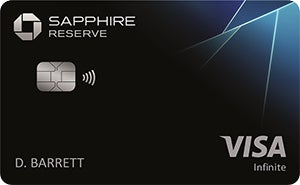Summary
If you’re interested in the Chase Sapphire Preferred because the annual fee is more affordable, we suggest you take a closer look at the Chase Sapphire Reserve, which offers a better value for many frequent travelers.
The content on this page is accurate as of the posting date; however, some of our partner offers may have expired. Please review our list of best credit cards, or use our CardMatch™ tool to find cards matched to your needs.
If you’re searching for a top travel card to help fund your next vacation, the Chase Sapphire cards may be your best bet. Both the Chase Sapphire Preferred® Card and the Chase Sapphire Reserve® can help you earn a lot of points, but they both come with drastically different price tags. The Chase Sapphire Preferred charges $95 per year for card membership, while the Chase Sapphire Reserve charges a hefty $550 annual fee.
Perhaps you’ve already decided that the Chase Sapphire Reserve’s fee is beyond your means and you’re ready to apply for the Chase Sapphire Preferred. However, we suggest that you pause for a moment and carefully compare the two cards. Our analysis suggests that the Chase Sapphire Reserve is the better value for many cardholders. Plus, thanks to its $300 annual travel credit and other reimbursements that make up for most of its annual fee, it’s a surprisingly affordable option.
Read on to see which card is the better option for you.
Card details
| Card |
| |
|---|---|---|
| Rewards |
|
|
| Annual fee | $95 | $550 |
| Welcome bonus | 60,000 points if you spend $4,000 in first 3 months | 60,000 points if you spend $4,000 in first 3 months |
| Introductory APR | N/A | N/A |
Chase Sapphire Preferred vs. Chase Sapphire Reserve
Welcome offer
| Chase Sapphire Preferred | Chase Sapphire Reserve |
|---|---|
| 60,000 points if you spend $4,000 in first 3 months | 60,000 points if you spend $4,000 in first 3 months |
The winner: Chase Sapphire Reserve
For the Chase Sapphire Preferred, new cardholders can earn 60,000 bonus points after spending $4,000 in the first three months of card membership and for the Chase Sapphire Reserve you can earn 60,000 bonus points after spending $4,000 in the first three months. Although their welcome bonuses are both generous, the Chase Sapphire Reserve is the better choice if you’ve been brainstorming future vacations or weekend getaways. The Chase Sapphire Reserve’s bonus is worth $900 when redeemed for travel through Chase Ultimate Rewards, whereas the Chase Sapphire Preferred’s bonus is worth $750 when redeemed for travel through Ultimate Rewards. This is because the former offers a 50 percent points boost when points are redeemed in this manner, while the latter only offers a 25 percent points boost for this redemption method.
Rewards rate
| Chase Sapphire Preferred | Chase Sapphire Reserve |
|---|---|
|
|
The winner: Chase Sapphire Reserve
It doesn’t require as much spending as you’d expect to see the value in the Chase Sapphire Reserve, thanks to the card’s higher earning rates in many categories. You’ll earn a higher rewards rate of 10X points on hotel stays and car rentals booked through Chase Ultimate Rewards, plus 10X points on Lyft rides (through March 31, 2025) and 3X points on general travel purchases. You’ll also earn 10X points on Chase Dining purchases.
That said, you’ll earn more with the Chase Sapphire Preferred in a few bonus categories — 3X points on select streaming services and online grocery purchases (excluding Walmart, Target and wholesale clubs). And with either card, you’ll earn the same 5X points on flights booked through Chase Ultimate Rewards and 3X points on dining purchases.
Annual fee
| Chase Sapphire Preferred | Chase Sapphire Reserve |
|---|---|
| $95 | $550 |
The winner: Chase Sapphire Preferred
If you prefer not to risk the high annual fee on the Chase Sapphire Reserve — because you’re not certain you can charge enough travel expenses to use the travel credit, or you simply can’t afford to pay $550 per year — the Chase Sapphire Preferred is a great option with a much lower annual fee. For $95 per year, you’ll get many of the same features as the Chase Sapphire Reserve, including the same welcome offer, flexible redemption options, 1:1 points transfers and fantastic travel protections. Additionally, with the Chase Sapphire Preferred, you’ll get a $50 annual statement credit for hotel bookings made through the Chase portal, which can help you recoup more than half of the card’s annual fee.
Still, be sure to do the math before you opt for the Chase Sapphire Preferred simply because the fee is lower. For many cardholders, the Chase Sapphire Reserve can be a better option due to its higher rewards rate and numerous travel perks.
Additional perks
| Chase Sapphire Preferred | Chase Sapphire Reserve |
|---|---|
|
|
The winner: Chase Sapphire Reserve
When you add together the additional perks and travel credits for the Chase Sapphire Reserve, the value of the card easily outmatches its annual fee (and that’s not including the extra points you earn on travel, dining and Lyft rides). For example, the Chase Sapphire Reserve offers generous travel credits — an annual $300 travel credit that covers anything that Chase categorizes as a travel purchase (including airfare), and an up to $100 statement credit every four years for Global Entry, TSA PreCheck or NEXUS. If you are a frequent traveler, you should be able to easily recoup $300 in travel costs, which will cancel out most of the card’s annual fee.
Additionally, the Chase Sapphire Reserve offers access to over 1,300 Priority Pass airport lounges. While there are many competing luxury cards that come with lounge access — like The Platinum Card® from American Express, which offers the largest lounge network and includes the ultra-swanky Centurion lounges — the Chase Sapphire Reserve still offers a good value on lounge access.
Travel and purchase insurance
| Chase Sapphire Preferred | Chase Sapphire Reserve |
|---|---|
|
|
The winner: Chase Sapphire Reserve
Both Chase Sapphire cards come with great travel insurance and purchase protections, including primary car rental insurance, trip cancellation and interruption insurance, trip delay insurance, purchase protection and extended warranty coverage. However, the Chase Sapphire Reserve has the edge over the Chase Sapphire Preferred in terms of comprehensive travel and purchase coverage. It offers more extensive primary car rental insurance, enhanced trip delay insurance and purchase protection, emergency evacuation and transportation insurance (in case of a medical issue while traveling abroad) and return protection on eligible items.
Which card should you get?
The $550 annual fee on the Chase Sapphire Reserve card may give you sticker shock, but think things through before you opt for a card with a lower annual fee. There is a large amount of value hidden beneath the Chase Sapphire Reserve’s glossy surface. Still, the choice between the Chase Sapphire Preferred and Chase Sapphire Reserve almost exclusively comes down to your travel and dining expenses.
- If you’re new to travel cards: If you have good-to-excellent credit and want to get your feet wet before you dive into a more complex rewards program, the Chase Sapphire Preferred is a great starter travel card. Since the Chase Sapphire Preferred’s points transfer to a variety of travel programs, you can learn the ropes of a few airline loyalty programs and test out transferring points to miles for a relatively small $95 annual fee.
- If you value airport lounge access: If you’re looking for a credit card with airport lounge access, then the Chase Sapphire Reserve is the better option between these two. If you don’t picture yourself kicking back in airport lounges, though, it shouldn’t necessarily be a deal-breaker — you can get plenty of value out of the Chase Sapphire Reserve’s other features.
- If you spend a lot on travel and dining: If you can afford the annual fee with the Chase Sapphire Reserve, you’ll generally earn twice as many points on travel and dining purchases (through the Chase portal). Plus, you’ll get a $300 travel credit and a 50 percent points boost when you redeem points for travel through Chase Ultimate Rewards, making the Chase Sapphire Reserve the better value.
Bottom line
The Chase Sapphire Preferred and Chase Sapphire Reserve are two wildly popular travel cards for good reason — they both offer highly flexible rewards that can be a great value for many types of cardholders. In the battle between these cards, the Chase Sapphire Reserve has a clear advantage thanks to its numerous benefits and credits. If you’re leaning toward the Chase Sapphire Preferred, you’ll want to do some careful math before you apply. Chase only allows you one Chase Sapphire card at a time, and you may have to wait a year or longer before you can change to a different card. Ultimately, be sure to choose the card that matches.
Editorial Disclaimer
The editorial content on this page is based solely on the objective assessment of our writers and is not driven by advertising dollars. It has not been provided or commissioned by the credit card issuers. However, we may receive compensation when you click on links to products from our partners.







